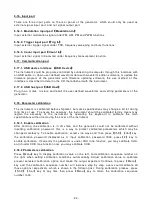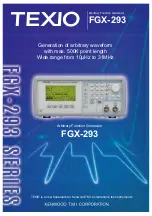
If use a U disk to store user-defined waveforms, the generator creates automatically in the U disk
corresponding file name WAVE11.ARB
~
WAVE15.ARB according to waveform sequence numbers,
and then store the user-defined waveforms data to corresponding file. If use a U disk to store
setting parameters, the generator creates automatically in the U disk corresponding file name
SETUP1.SET ~ SETUP5.SET according to memory area numbers, and then store the setting
parameters to corresponding file. If U disk storage failed, the generator will make an alarm. When
recall form a U disk, the generator will find in the U disk matched file name according to the input
of user-defined waveform sequence number or setting parameter memory area number, and if find
the match file, the data in this file will be recalled, and there is no matched file name in the U disk,
the recall operation failed and the generator will make an alarm.
Using a U disk memory makes it possible to store and recall user-defined waveforms and setting
parameters, so several users could use one generator.
5.14. Frequency measurement
The generator is designed to be added a pulse counter, with which the users could measure
frequency of signals, this pulse counter has completely no relationship with the function/arbitrary
waveform generator but is only one more function of the generator.
Connect the signal to be tested to the
《
Count In
》
port on the rear panel of the generator, press
【
Count
】
key and the “Count” keyboard indicator will be on, and a twinkling “Gate” mark will
appear on the down-right corner of the screen, now the generator starts to measure the frequency
of the input signal and show the measurement value at the same time.
5.14.1. Gate time setting
Press
【
Menu
】
key and select “Gate” option, the frequency measurement will stop and the users
now could set gate time value. The frequency measurement will resume after finishing the gate
time setting, and the twinkle rate of the “Gate” mark will change too. The gate time indicates the
sampling interval time of tested signal, the longer the gate time is, the more the sampling data, so
the users may get more stable measurement result and higher measurement resolution. And the
shorter the gate time is, the better the tested signal is tracked, but short gate time will result in
low measurement resolution. Generally, gate time should be longer than the period of tested
signal.
5.14.2. Coupling mode
The tested signal adapts AC coupling method, and the input attenuation is comparatively larger
when frequency is comparatively lower, so when frequency is lower than 10Hz, the users should
better increase the amplitude of the tested signal properly.
5.14.3. Low-pass filter
When the frequency of tested signal is comparatively low and with a high-frequency noise added
with it, the high-frequency noise may trigger the counter which will result in getting larger
measurement result compared with the correct value. In this case, a low-pass filter should be
used externally to filter the high-frequency noise in the tested signal, and to get correct
measurement result.
-22-








































